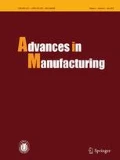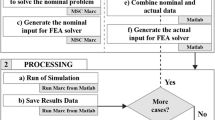Abstract
Adhesive joints are widely used in precision electromechanical products, and their bonding process has significant effects on the performance of an assembled product. This paper presents a numerical study on the bonding assembly of a sleeve structure of a precision inertial device using a finite element method, where the stresses due to curing and relaxation behaviors are considered. The effects of assembly errors and bonding defects on the centroid drift of the sleeve structure were found and analyzed quantitatively. This study can help understand the zero-drift mechanism of the precision inertial device and contribute valuable data for its error compensation.















Similar content being viewed by others
References
Banea MD, Da Silva LFM (2009) Adhesively bonded joints in composite materials: an overview. Proc Inst Mech Eng Part L J Mater Des Appl 223(1):1–18
Kinloch AJ (1987) Adhesion and adhesives: science and technology. Chapman & Hall, London
Baldan A (2004) Adhesively-bonded joints and repairs in metallic alloys, polymers and composite materials: adhesives, adhesion theories and surface pretreatment. J Mater Sci 39:1–49
Machalická K, Eliášová M (2017) Adhesive joints in glass structures: effects of various materials in the connection, thickness of the adhesive layer, and ageing. Int J Adhes Adhes 72:10–22
Ehrhart B, Valeske B, Muller CE et al (2010) Methods for the quality assessment of adhesive bonded CFRP structures: a resumé. In: The 2nd international symposium on NDT in aerospace 2010, Hamburg, Germany, 22–24 November, pp 1–9
Guyott CCH, Cawley P, Adams RD et al (2016) The non-destructive testing of adhesively bonded structure: a review. J Adhes 8464:37–41
Elhannani M, Madani K, Legrand E et al (2017) Numerical analysis of the effect of the presence, number and shape of bonding defect on the shear stresses distribution in an adhesive layer for the single-lap bonded joint, Part 1. Aerosp Sci Technol 62:122–135
Jairaja R, Naik GN (2019) Weak bond effects in adhesively bonded joints between the dissimilar adherends. J Adhes. https://doi.org/10.1080/00218464.2019.1702027
Heslehurst RB (1999) Observations in the structural response of adhesive bondline defects. Int J Adhes Adhes 19(2/3):133–154
Elhannani M, Madani K, Chama Z et al (2017) Influence of the presence of defects on the adhesive layer for the single-lap bonded joint—Part II: probabilistic assessment of the critical state. Aerosp Sci Technol 63:372–386
Geleta TN, Woo K, Cairns DS et al (2018) Failure behavior of inclined thick adhesive joints with manufacturing defect. J Mech Sci Technol 32:2173–2182
Shishesaz M, Bavi N (2013) Shear stress distribution in adhesive layers of a double-lap joint with void or bond separation. J Adhes Sci Technol 27:1197–1225
Majid JO, Mohammad RMS (2018) Investigation of defect effects on adhesively bonded joint strength using cohesive zone modeling. J Mech Eng Stroj Cas 68:5–24
Heidarpour F, Farahani M, Ghabezi P (2018) Experimental investigation of the effects of adhesive defects on the single lap joint strength. Int J Adhes Adhes 80:128–132
Costa M, Viana G, Da Silva LFM et al (2017) Environmental effect on the fatigue degradation of adhesive joints: a review. J Adhes 93:127–146
Awaja F, Gilbert M, Kelly G et al (2009) Adhesion of polymers. Prog Polym Sci 34:948–968
Marques EAS, Da Silva LFM, Banea MD et al (2014) Adhesive joints for low- and high-temperature use: an overview. J Adhes 91:556–585
Ramírez FMG, de Moura MFSF, Moreira RDF et al (2020) A review on the environmental degradation effects on fatigue behaviour of adhesively bonded joints. Fatigue Fract Eng Mater Struct 43:1307–1326
Miravalles M, Dharmawan IIP (2007) The creep behaviour of adhesives a numerical and experimental investigation. Dissertation, Chalmers University of Technology, Göteborg, Sweden
French P, Krijnen G, Roozeboom F (2016) Precision in harsh environments. Microsyst Nanoeng 2:1–12
Zha G, Huang X, Liu W (2016) Research on heading sensitive drift storage behavior of inertial platform system under the action of assembly stress relaxation. In: Proceedings of 2016 prognostics and system health management conference, Chengdu, 19–21 October, pp 1–6
Zhou W, Li F, Yu H et al (2017) Influence of adhesive non-uniformity on zero offset of micro accelerometer. Int J Mod Phys B 31:1–8
Zhou W, Peng P, Yu H et al (2017) Material viscoelasticity-induced drift of micro-accelerometers. Materials (Basel) 10:1–11
Zarnik MS, Rocak D, Macek S (2004) Residual stresses in a pressure-sensor package induced by adhesive material during curing: a case study. Sensors Actuators A Phys 116:442–449
Zhang Z, Wan Z, Liu C et al (2010) Effects of adhesive material on the output characteristics of pressure sensor. In: The 11th international conference on electronic packaging technology and high density packaging, Xi'an, 16–19 August, pp 657–660
Chuang CH, Huang YH, Lee SL (2012) The influence of adhesive materials on chip-on-board packing of MEMS microphone. Microsyst Technol 18:1931–1940
Peng P, Zhou W, Yu H et al (2016) Investigation of the thermal drift of MEMS capacitive accelerometers induced by the overflow of die attachment adhesive. IEEE Trans Compon Packag Manuf Technol 6:822–830
Zhang J, Li Y, Zhang F (2019) Analysis of centroid variation of three-floating gyroscope based on error sensitivity. In: IOP conference series: materials science and engineering, 20–22 September 2019, Hefei, China, pp 12–16
Chen X, Zhang Z, Jin X et al (2018) Effects of bonding position error on the motion precision stability of precision motor system under temperature load. Navig Control 17:69–74
Yao Z, Hu J, Zhang Z (2018) Assembly technology of structure stability control for high precision gyroscope. J Mech Eng 54:145–152
Lide DR, Baysinger G (2005) CRC handbook of chemistry and physics. CRC Press, Boca Raton
Mainardi F, Spada G (2011) Creep, relaxation and viscosity properties for basic fractional models in rheology. Eur Phys J Spec Top 193:133–160
Chen X, Zhang Z, Jin X et al (2018) Simulation method for precision bonding structure with micron scale adhesive layer. In: The 7th CIRP conference on assembly technologies and systems, 10–12 May 2018, Tianjin, pp 100–105
Acknowledgments
This work was financially supported by the Natural Science Foundation of Beijing (Grant No. 3204054), the National Natural Science Foundation of China (Grant Nos. 51935003, 51905038), and the National Fundamental Scientific Research (Grant No. JCKY2019203B031).
Author information
Authors and Affiliations
Corresponding author
Rights and permissions
About this article
Cite this article
Liu, JH., Li, XY., Xia, HX. et al. Effects of assembly errors and bonding defects on the centroid drift of a precision sleeve structure. Adv. Manuf. 9, 509–519 (2021). https://doi.org/10.1007/s40436-021-00346-1
Received:
Revised:
Accepted:
Published:
Issue Date:
DOI: https://doi.org/10.1007/s40436-021-00346-1




